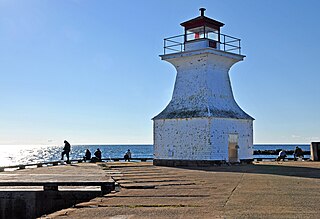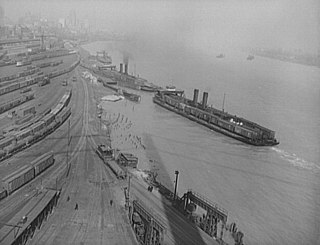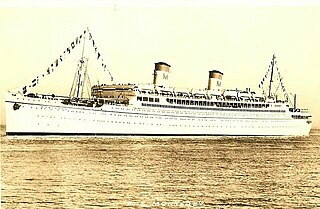
Cabot Strait is a strait in eastern Canada approximately 110 kilometres wide between Cape Ray, Newfoundland and Cape North, Cape Breton Island. It is the widest of the three outlets for the Gulf of Saint Lawrence into the Atlantic Ocean, the others being the Strait of Belle Isle and Strait of Canso. It is named for the Genoese explorer Giovanni Caboto.

Pocahontas was a Native American woman notable for her association with the colonial settlement at Jamestown, Virginia. She was the daughter of Powhatan, the paramount chief of a network of tributary tribes in the Tsenacommacah, encompassing the Tidewater region of Virginia.

The Cape May–Lewes Ferry is a ferry system in the United States that traverses a 17-mile (27 km) crossing of the Delaware Bay to connect North Cape May, New Jersey with Lewes, Delaware. The ferry constitutes a portion of U.S. Route 9, and is the final crossing of the Delaware River-Delaware Bay waterway before it meets the Atlantic Ocean.

Cape Tormentine is a local service district in southeastern New Brunswick, Canada. It is located on the Northumberland Strait at the Abegweit Passage, the shortest crossing between Prince Edward Island and the mainland. It once flourished as a transportation hub between New Brunswick and Prince Edward Island but has been in decline since 1997 when the ferry service was closed due to the opening of the Confederation Bridge. At the Canada 2011 Census the population was 108, three quarters what it was at the 2006 census.

The Jamestown Ferry is a free automobile and bus ferry service across a navigable portion of the James River in Virginia. It carries State Route 31, connecting Jamestown in James City County with Scotland Wharf in Surry County.
Pocahontas was a Pamunkey Algonquian chief's daughter from early American history.

North Sydney is a former town and current community in Nova Scotia's Cape Breton Regional Municipality.

A train ferry is a ship (ferry) designed to carry railway vehicles. Typically, one level of the ship is fitted with railway tracks, and the vessel has a door at the front and/or rear to give access to the wharves. In the United States, train ferries are sometimes referred to as "car ferries", as distinguished from "auto ferries" used to transport automobiles. The wharf has a ramp, and a linkspan or "apron", balanced by weights, that connects the railway proper to the ship, allowing for the water level to rise and fall with the tides.

USS Pocahontas (SP-3044) was a transport ship for the United States Navy during World War I. She was originally SS Prinzess Irene, a Barbarossa-class ocean liner built in 1899 by AG Vulcan Stettin of Stettin, Germany, for the North German Lloyd line.

HMAS Kuttabul, formerly SS Kuttabul, was a Royal Australian Navy depot ship, converted from a Sydney Ferries Limited ferry.
SS Caribou was a Newfoundland Railway passenger ferry that ran between Port aux Basques, in the Dominion of Newfoundland, and North Sydney, Nova Scotia between 1928 and 1942. During the Battle of the St. Lawrence the ferry was attacked and sunk by the German submarine U-69 in October 1942, while traversing the Cabot Strait as part of her three weekly SPAB convoys. As a civilian vessel, she had women and children on board, and many of them were among the 137 who died. Her sinking, and large death toll, made it clear that the war had really arrived on Canada's and Newfoundland's home front, and is cited by many historians as the most significant sinking in Canadian-controlled waters during the Second World War.

Borden-Carleton is a town in Prince County the Canadian province of Prince Edward Island. It is situated on the south shore fronting on the Northumberland Strait. The town was originally incorporated as a community on April 12, 1995, through the amalgamation of the town of Borden and the community of Carleton. The town of Borden opted to demote its status to a community in light of a declining tax base with the pending completion of the Confederation Bridge and the closure of the Marine Atlantic ferry service. Borden-Carleton became a town on July 31, 2012.

A Landing ship, infantry (LSI) or infantry landing ship was one of a number of types of British Commonwealth vessels used to transport landing craft and troops engaged in amphibious warfare during the Second World War. LSIs were operated by the Royal Navy, British Merchant Navy, Royal Canadian Navy, Royal Indian Navy, and Royal Australian Navy. They transported British Commonwealth and other Allied troops in sea assaults and invasions throughout the war.

The Woods Hole, Martha's Vineyard and Nantucket Steamship Authority, doing business as The Steamship Authority (SSA), is the statutory regulatory body for all ferry operations between mainland Massachusetts and the islands of Martha's Vineyard and Nantucket, as well an operator of ferry services between the mainland and the islands. It is the only ferry operator to carry automobiles to and from the islands. The Authority also operates several freight vessels, thus serving as the main link for shipping any commercial goods that are not transported using the airports on Nantucket or Martha's Vineyard.

The Little Creek-Cape Charles Ferry was a passenger ferry service operating across the mouth of the Chesapeake Bay from the 1930s until 1964. Known also as the Princess Anne-Kiptopeke Beach Ferry or Little Creek-Kiptopeke Beach Ferry, the service connected Virginia Beach, Virginia with Cape Charles on the Eastern Shore of Virginia. Departures from and arrivals to Cape Charles were matched with times of Pennsylvania Railroad passenger trains such as the Del-Mar-Va Express and the Cavalier that operated up the length of the Delmarva Peninsula.

The SS Thomas T. Tucker was a Liberty ship built by The Houston Shipbuilding Corporation for service as a troop and weapons carrier.

The State Dockyard was a ship building and maintenance facility operated by the Government of New South Wales in Carrington, Newcastle, New South Wales, Australia between 1942 and 1987.

SS Monterey was a luxury ocean liner launched on 10 October 1931. The ship was completed April 1932 and is shown in registers as a 1932 ship. Monterey was the third of the four ships of the Matson Lines "White Fleet", which were designed by William Francis Gibbs and also included SS Malolo, SS Mariposa and SS Lurline. Monterey was identical to Mariposa and very similar to Lurline. During World War II Monterey was used as a troopship operated by Matson as agents of the War Shipping Administration (WSA). Monterey was a large, fast transport capable of sailing independently and was allocated to serving Army troop transport requirements. The ship was involved in an attack on a convoy near Cape Bougaroun.

Lower Thames and Medway Passenger Boat Company is a river boat company which provides cruises on the River Thames in Gravesend and London, UK. Bateaux London cruises operate on the Thames under licence from London River Services, part of Transport for London.

The SS Cape Isabel (AKR-5062) was originally launched in 1976 as the SS Nevada, a Type C7 commercial ship. The States SS company took the first contract in 1976 and it operated until it was transferred to Lykes Brothers steamship company and renamed the SS Charles Lykes. Later the ship was reacquired from its commercial roles and brought back under military control via the Maritime Administration and renamed the Cape Isabel. Since then it has been kept in ready reserve status and used occasionally for heavy lifting operations to European theaters to have equipment air-lifted to active engagements. It has heavily participated in Operation Enduring Freedom ferrying goods across the Atlantic to staging points in Europe.

















